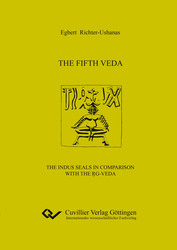| Departments | |
|---|---|
| Book Series (96) |
1378
|
| Nachhaltigkeit |
3
|
| Gesundheitswesen |
1
|
| Humanities |
2365
|
| Medienwissenschaften | 16 |
| Theology | 57 |
| Philosophy | 102 |
| Law | 422 |
| Economics | 850 |
| Social sciences | 416 |
| Sports science | 48 |
| Psychology | 233 |
| Educational science | 190 |
| History | 182 |
| Art | 111 |
| Cultural studies | 166 |
| Literary studies | 117 |
| Linguistics | 88 |
| Natural Sciences |
5406
|
| Engineering |
1793
|
| Common |
98
|
|
Leitlinien Unfallchirurgie
5. Auflage bestellen |
|
Advanced Search
The fifth Veda (English shop)
The Indus seals in comparison with the R̥g-Veda
Egbert Richter-Ushanas (Author)Preview
Extract, PDF (450 KB)
Table of Contents, PDF (220 KB)
The Fifth Veda is an abridged version of Der Fünfte Veda whose latest edition has been published in 2016. The first two chapters and the chapter on the Brāhmī script are almost identical. The investigation of the geo¬metrical signs and of the horse in chapter VII has been added.
The English reading is identical with the text in The message of the Indus seals and tablets, whose latest edition appeared in 2016.
The master-key of the decipherment in all versions is the discovery of the basic symbolic and linguistic agreement of the Indus inscriptions with the R̥g-Veda. This basic agreement is called the Fifth Veda. It has nothing to do with the Mahābhārata or the Bhāgavata Purāṇa generally called by this name. There are similarities with the Natya Śastra, the book dealing with the Indian dance. Its author Bharata is identical to Agni and Rudra-Śiva, that means, the Indian dance originated in the Indus culture.
The prototype of a female dancer is the Dawn who a (sacred) prostitute and a loving house-wife as well. Her dance is compared to the move¬ment of the soma-press.
| ISBN-13 (Hard Copy) | 9783736993853 |
| Final Book Format | A5 |
| Language | English |
| Page Number | 108 |
| Edition | 1. Aufl. |
| Publication Place | Göttingen |
| Publication Date | 2016-12-07 |
| General Categorization | Non-Fiction |
| Departments |
Pre- and early history
Archeology Linguistics Literary studies Non-European linguistics, literary studies and cultural studies (including religious studies) |
| Keywords | Terracotta-tables, geometrical signes, Vedic paraphrase |








